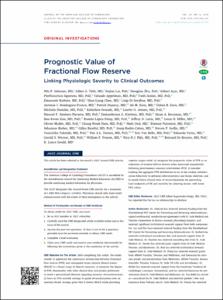KUMEL Repository
1. Journal Papers (연구논문)
1. School of Medicine (의과대학)
Dept. of Internal Medicine (내과학)
Prognostic Value of Fractional Flow Reserve : Linking Physiologic Severity to Clinical Outcomes
- Keimyung Author(s)
- Nam, Chang Wook
- Department
- Dept. of Internal Medicine (내과학)
- Journal Title
- Journal of the American College of Cardiology
- Issued Date
- 2014
- Volume
- 64
- Issue
- 16
- Keyword
- fractional flow reserve; meta-analysis; prognosis; threshold
- Abstract
- BACKGROUND Fractional flow reserve (FFR) has become an established tool for guiding treatment, but its graded relationship to clinical outcomes as modulated by medical therapy versus revascularization remains unclear.
OBJECTIVES The study hypothesized that FFR displays a continuous relationship between its numeric value and prognosis, such that lower FFR values confer a higher risk and therefore receive larger absolute benefits from revascularization.
METHODS Meta-analysis of study- and patient-level data investigated prognosis after FFR measurement. An interaction term between FFR and revascularization status allowed for an outcomes-based threshold.
RESULTS A total of 9,173 (study-level) and 6,961 (patient-level) lesions were included with a median follow-up of 16 and 14 months, respectively. Clinical events increased as FFR decreased, and revascularization showed larger net benefit for lower baseline FFR values. Outcomes-derived FFR thresholds generally occurred around the range 0.75 to 0.80, although limited due to confounding by indication. FFR measured immediately after stenting also showed an inverse relationship with prognosis (hazard ratio: 0.86, 95% confidence interval: 0.80 to 0.93; p < 0.001). An FFR-assisted strategy led to revascularization roughly half as often as an anatomy-based strategy, but with 20% fewer adverse events and 10% better angina relief.
CONCLUSIONS FFR demonstrates a continuous and independent relationship with subsequent outcomes, modulated by medical therapy versus revascularization. Lesions with lower FFR values receive larger absolute benefits from revascularization. Measurement of FFR immediately after stenting also shows an inverse gradient of risk, likely from residual diffuse disease. An FFR-guided revascularization strategy significantly reduces events and increases freedom from angina with fewer procedures than an anatomy-based strategy.
- Keimyung Author(s)(Kor)
- 남창욱
- Publisher
- School of Medicine
- Citation
- Nils P. Johnson et al. (2014). Prognostic Value of Fractional Flow Reserve : Linking Physiologic Severity to Clinical Outcomes. Journal of the American College of Cardiology, 64(16), 1641–1654. doi: 10.1016/j.jacc.2014.07.973
- Type
- Article
- ISSN
- 0735-1097
- Appears in Collections:
- 1. School of Medicine (의과대학) > Dept. of Internal Medicine (내과학)
- 파일 목록
-
-
Download
 oak-aaa-2317.pdf
기타 데이터 / 859.01 kB / Adobe PDF
oak-aaa-2317.pdf
기타 데이터 / 859.01 kB / Adobe PDF
-
Items in Repository are protected by copyright, with all rights reserved, unless otherwise indicated.